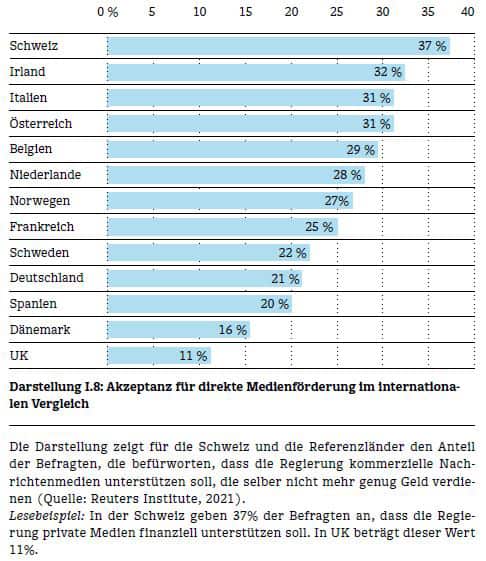Corona and disinformation: importance of journalism on the rise
Quality media perform a classification function in the Corona pandemic and curb disinformation. But the economic situation of journalism has deteriorated further. Acceptance of media funding, on the other hand, is relatively high in Switzerland.
The Research Center Public and Society Fög of the University of Zurich published its yearbook "Quality of the Media 2021" on Monday. The center has been examining the development of the Swiss media annually since 2010.
According to the report, the topic of disinformation - i.e. intentionally spreading false news - has definitely arrived in Switzerland with the Corona pandemic. This is shown by the results of a representative survey conducted by Fög in Switzerland at the end of 2020.
Almost half of the respondents (49%) consider disinformation to be a "major" to "very major" problem, especially in dealing with social crises. Just under a quarter say they "often" to "very often" encounter false news. The study participants cite social media (62%), alternative media (39%), video portals (36%) or messenger apps (28%) as the main sources of disinformation. Professional journalistic media such as news sites (20%) or television (13%) are less often cited as sources of disinformation. On the contrary, the population uses information from journalistic media (61%) and from the federal government and authorities (68%) to check the content of fake news.
More classification by the media
In the second wave of the pandemic, the media also pay very high attention to the topic of Corona - but less than in the first wave, despite rising case numbers. The coronavirus is also presented explicitly as a threat less frequently (6%) than in the first wave (16%). "A "scaremongering", as the media is often accused of, can thus not be empirically determined", says media expert and Fög director Mark Eisenegger. The proportion of media reports that are very positive towards the authorities remains low (0.3%). Thus, the accusation of uncritical "court reporting" is not confirmed. Figures and statistics are classified more frequently by the media compared to the first wave (21% vs. 12% in the first wave), which is positive.
Limited diversity of experts
Another conclusion of the report is that the diversity of experts in the second wave of the pandemic remains severely limited, however. Thus, voices from medicine, virology, and epidemiology continue to dominate, despite the fact that almost all sectors of society are affected by the pandemic. Female scientists have become more visible (21% vs. 12% in the first wave), but remain significantly underrepresented compared to their male colleagues.
This underrepresentation of women persists in media coverage beyond Corona, as another Fög study on the portrayal of women in Swiss media shows. A limited diversity is also confirmed by an examination of the referendum campaign on the veiling ban of March 7, 2021. The Muslim minority concerned is not very visible on Twitter (13%) and in the media (11%). Instead of letting them have their say, there was more often only general talk about Muslims.
More quality in commuter and tabloid media online
According to the Fög report, media quality remains stable overall, but is changing in individual dimensions. The media provide more information on politics (37%, +5 percentage points year-on-year) and less on soft news such as sports (10%, -1.5 PP) and human interest (30%, -1.3 PP). The share of classified services in the form of background articles did not decline for the first time in six years.
Media types such as public broadcasting and subscription news sites continue to excel in quality. But the commuter and tabloid media online can improve their quality due to the event situation and the stronger focus on politics.
The concentration of content, i.e. the sharing of identical articles in several media, has become more pronounced in German-speaking Switzerland. In 2020, this can be seen in almost all subject areas, but especially in cultural reporting.
Media promotion is strongly accepted
The Corona pandemic has further worsened the economic situation of the media, the report says. For the first time since 2014, revenues from the online advertising market are also declining. Although willingness to pay for online news is growing slightly (17%, +4 PP). However, this is not enough to sustainably finance journalism.
According to Fög, more active media support is not rejected in principle. 37% of respondents are of the opinion that the state should support private media if they get into difficulties; 37% are against, 26% are undecided. In an international comparison, acceptance of direct media support in Switzerland is thus strikingly high.
Good journalism needs resources
The results of the Yearbook show that professional media have become even more important as a result of the pandemic. Media provide orientation, supply the population with reliable information and are also able to check and refute false news. Good journalism, which is supposed to fulfill its democratic functions, needs resources. "It is becoming increasingly apparent that high-quality journalism can only be financed through direct media funding," Eisenegger is convinced. This should also support smaller media providers and startups in particular, which contribute to a diversity of voices and to informing the population. (pd/swi)












